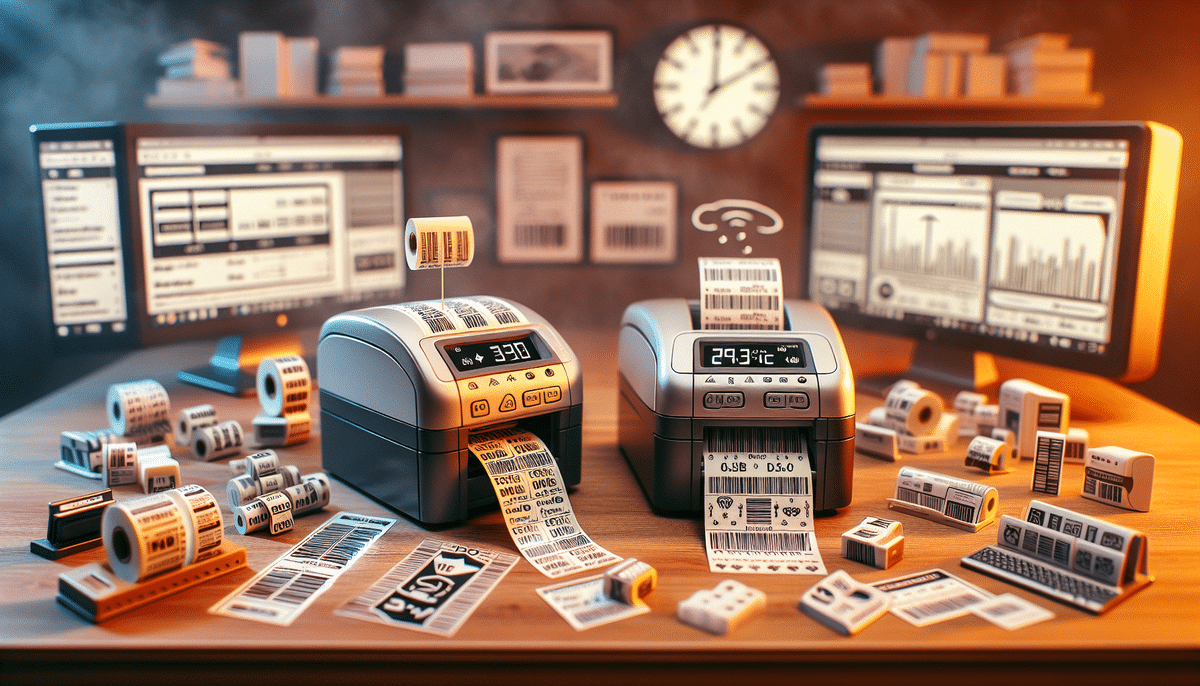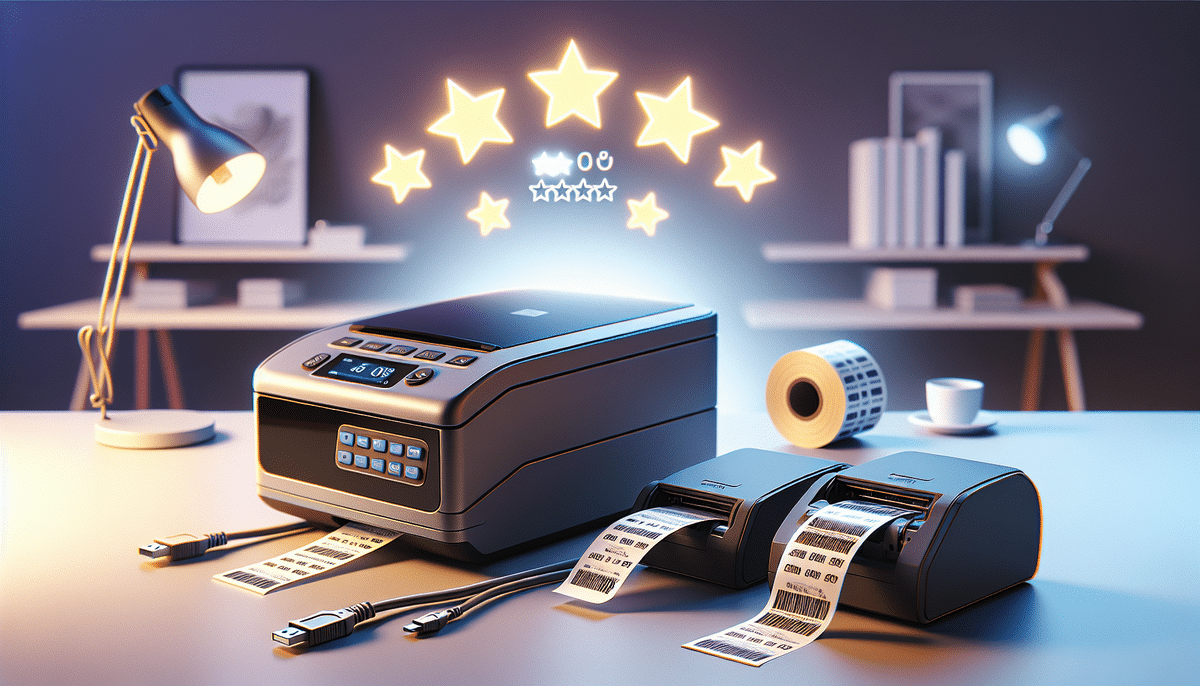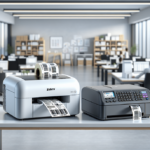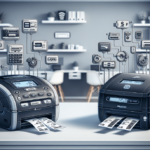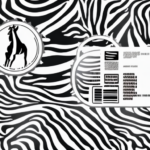Why Label Printers are Essential for Modern Businesses
Label printers are indispensable tools for businesses that need to create labels for shipping, inventory management, barcodes, and various other applications. These devices enhance convenience, efficiency, and accuracy in labeling and organizing products or materials. By eliminating the need for manual labeling or using standard printers, label printers can significantly reduce time and increase productivity.
One of the key advantages of label printers is their ability to produce labels in a wide range of sizes and formats, tailored to the specific needs of a business. This flexibility allows for customization, making labels more visually appealing and reinforcing brand recognition. Additionally, label printers can handle different types of materials, such as vinyl, polyester, or paper, ensuring that labels are durable and suitable for various environmental conditions.
From a cost perspective, label printers offer long-term savings by reducing the necessity to outsource label printing services or purchase pre-printed labels. Having an in-house label printer enables businesses to print labels on demand, minimizing waste and lowering inventory costs. Furthermore, label printers are typically easy to operate and require minimal maintenance, allowing businesses to focus on their core activities without the burden of complex equipment upkeep.
Key Features of DYMO LabelWriter 450 Turbo vs Zebra ZP450
Both the DYMO LabelWriter 450 Turbo and the Zebra ZP450 offer robust features such as thermal printing, adjustable label widths, and compatibility with various label sizes. However, there are notable differences between the two:
- Print Resolution: The DYMO LabelWriter 450 Turbo boasts a higher maximum resolution of 600 x 300 dpi, allowing for more detailed and precise labels compared to the Zebra ZP450's 203 dpi.
- Built-in Features: The DYMO printer includes a built-in label peeler, which streamlines the process of handling multiple labels.
- Connectivity: The DYMO LabelWriter 450 Turbo offers both USB and Ethernet connectivity, facilitating seamless integration into various network environments. In contrast, the Zebra ZP450 is limited to USB connectivity.
- Software Packages: DYMO provides a complimentary software package with label design capabilities, whereas the Zebra ZP450 may require separate software purchases for comprehensive label design functionality.
Print Quality: DYMO LabelWriter 450 Turbo vs Zebra ZP450
When assessing print quality, both printers deliver clear and legible outputs. However, the DYMO LabelWriter 450 Turbo's superior resolution ensures sharper and more detailed labels, which is crucial for businesses that need high-quality text and graphics on their labels.
On the other hand, the Zebra ZP450 offers faster print speeds, making it suitable for businesses that require high-volume label printing. The DYMO printer supports a broader range of label sizes and types, providing greater versatility in labeling options. The choice between these two models ultimately depends on whether a business prioritizes print resolution or printing speed.
Printing Speed: Evaluating DYMO LabelWriter 450 Turbo and Zebra ZP450
Print speed is a critical factor for businesses with high labeling demands. The Zebra ZP450 outpaces the DYMO LabelWriter 450 Turbo, with a maximum print speed of 5 inches per second compared to DYMO’s 4 labels per second. While this speed advantage is beneficial for larger operations, smaller businesses with lower printing volumes may not find the difference significant.
Cost of ownership is another consideration. The DYMO LabelWriter 450 Turbo generally has lower maintenance and replacement part costs compared to the Zebra ZP450, making it a cost-effective choice for businesses aiming to minimize operational expenses.
Ease of Use: DYMO LabelWriter 450 Turbo vs Zebra ZP450
The DYMO LabelWriter 450 Turbo is renowned for its user-friendly design, featuring an intuitive label loading system and a built-in label peeler. The plug-and-play nature of the DYMO printer ensures easy setup without the need for specialized technical knowledge. Additionally, the included utility software simplifies label customization and integration with other applications.
In contrast, the Zebra ZP450 may require more technical expertise for installation and operation. Its USB-only connectivity can also limit ease of integration in certain environments. The compact design of the DYMO printer allows it to fit seamlessly into various workspaces, whereas the Zebra model's larger footprint might necessitate additional space.
Software Compatibility and Integration
Both the DYMO LabelWriter 450 Turbo and Zebra ZP450 support Windows and Mac operating systems and integrate with popular software programs like Microsoft Word, Excel, and Outlook. However, the DYMO printer offers broader compatibility with third-party software, enhancing its flexibility for diverse business needs.
The Zebra ZP450 includes a built-in web server, facilitating integration with web-based applications and a wider array of shipping and label printing software. This feature makes the Zebra ZP450 especially attractive for e-commerce businesses that handle a high volume of shipping labels. Conversely, the DYMO LabelWriter 450 Turbo’s compact and portable design makes it ideal for small businesses or individuals requiring on-the-go labeling solutions.
Connectivity Options: Ensuring Seamless Integration
Connectivity options are crucial for integrating label printers into existing systems. The DYMO LabelWriter 450 Turbo supports both USB and Ethernet connections, allowing it to connect to single or multiple computers within a network. Meanwhile, the Zebra ZP450 enhances its connectivity by also offering Wi-Fi, enabling wireless printing from various devices and improving overall flexibility in different settings.
Customer Reviews: DYMO LabelWriter 450 Turbo
The DYMO LabelWriter 450 Turbo has garnered positive feedback for its ease of use, fast printing capabilities, and high-quality outputs. Users appreciate the convenience of the built-in label peeler and the extensive customization options provided by the software. However, some reviews mention occasional printer jams and the need for regular maintenance to ensure optimal performance.
Customer Reviews: Zebra ZP450
The Zebra ZP450 is praised for its speed, versatile connectivity options, and ability to handle various label sizes efficiently. Customers also highlight its durable construction and quiet operation as significant benefits. On the downside, some users have experienced connectivity issues and found the initial software setup to be challenging.
Price Comparison: DYMO LabelWriter 450 Turbo vs Zebra ZP450
In terms of pricing, the DYMO LabelWriter 450 Turbo is typically priced slightly higher than the Zebra ZP450, with differences ranging from approximately 5% to 20% depending on the retailer and available promotions. The higher cost of the DYMO printer may be justified by its superior resolution and built-in label peeler, which are valuable features for businesses requiring high-quality and efficient labeling solutions.
Choosing the Right Label Printer for Your Business
Both the DYMO LabelWriter 450 Turbo and Zebra ZP450 are reliable and versatile label printers capable of meeting the diverse labeling needs of businesses. The decision between the two should be based on specific business requirements, including:
- Printing Volume: High-volume needs may favor the faster Zebra ZP450.
- Print Quality: Businesses requiring detailed and high-resolution labels might prefer the DYMO LabelWriter 450 Turbo.
- Connectivity: If network integration and wireless printing are priorities, the Zebra ZP450 offers more options.
- Customization: The DYMO printer provides extensive software compatibility for customized label designs.
By evaluating the pros and cons of each printer and comparing their features and customer feedback, businesses can make an informed decision that aligns with their operational needs and budget.
Pros and Cons of the DYMO LabelWriter 450 Turbo
Pros:
- Built-in label peeler for efficient label handling
- Higher print resolution ensures detailed labels
- User-friendly design with easy setup
- Wide compatibility with third-party software
- High-quality and consistent prints
Cons:
- Occasional paper jams requiring maintenance
- Higher price point compared to some competitors
Pros and Cons of the Zebra ZP450
Pros:
- Faster print speeds suitable for high-volume printing
- Wi-Fi connectivity offers greater flexibility
- Handles a wide variety of label sizes and materials
- Durable construction suitable for heavy use
- Quiet operation enhances workplace comfort
Cons:
- Requires technical knowledge for initial setup
- Potential connectivity issues reported by some users
- Lower print resolution compared to the DYMO LabelWriter 450 Turbo
Comparison Table: DYMO LabelWriter 450 Turbo vs Zebra ZP450
| Feature | DYMO LabelWriter 450 Turbo | Zebra ZP450 |
|---|---|---|
| Print Resolution | 600 x 300 dpi | 203 dpi |
| Print Speed | 4 labels per second | 5 inches per second |
| Ease of Use | User-friendly design with built-in label peeler | May require technical knowledge for setup |
| Software Compatibility | Wider compatibility with third-party software programs | Compatible with Microsoft Word, Excel, and Outlook |
| Connectivity Options | USB, Ethernet | USB, Ethernet, Wi-Fi |
| Price (approx.) | $$ | $ |
Conclusion: Making the Best Choice for Your Labeling Needs
Both the DYMO LabelWriter 450 Turbo and the Zebra ZP450 are dependable label printers that offer significant advantages in terms of convenience, efficiency, and accuracy. The DYMO LabelWriter 450 Turbo stands out with its high-resolution printing and user-friendly features, making it ideal for businesses that prioritize print quality and ease of use. Conversely, the Zebra ZP450 excels in speed and connectivity options, catering to businesses that require rapid, high-volume label printing with flexible integration capabilities.
Ultimately, the best label printer for your business will depend on your specific needs, including the volume of labels you print, the level of detail required, your budget, and your preferred connectivity options. By carefully considering these factors and reviewing customer feedback and feature comparisons, you can select the label printer that best aligns with your operational objectives and enhances your business’s labeling efficiency.













